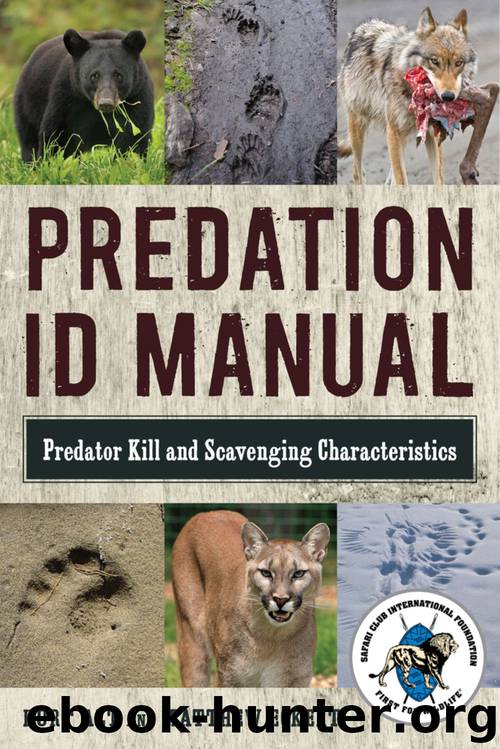Predation ID Manual by Kurt Alt

Author:Kurt Alt
Language: eng
Format: epub
Publisher: Skyhorse Publishing
Published: 2017-08-03T04:00:00+00:00
Typical carcass appearance after being fed on by brown bear, SW Montana.
Brown bear cache of elk showing debris, rocks, dirt, and so on, SW Montana.
Brown bear cache of moose, showing lighter debris, Alaska.
Brown bear cache of moose, Alaska.
Bears will peel the hide back, like a “banana peel,” but usually don’t eat much of the hide when consuming the carcass. What you see is a hide inverted back toward the foot with the lower leg bone sheared off. The hide has a skinned-out appearance.
Tracks are important for identifying the presence of bears. In geographical regions where black and brown bears overlap, it is important use track characteristics and hair identification to distinguish between the two species. The Palmisciano Method is a distinguishing method when using a track from the front foot (Appendix C, Bear Family). In addition, scat size can add information, but caution should be used due to similarities between species. Although the size/age of a bear are important, moisture content and fiber are critical factors affecting scat size (James Halfpenny personal communication)
Download
This site does not store any files on its server. We only index and link to content provided by other sites. Please contact the content providers to delete copyright contents if any and email us, we'll remove relevant links or contents immediately.
The Elements by Theodore Gray(2448)
Designing Your Life by Bill Burnett(2284)
The Meaning of it All by Richard Feynman(1915)
The Chimp Paradox by Peters Dr Steve(1869)
Why Is God Laughing?: The Path to Joy and Spiritual Optimism by Deepak Chopra(1839)
Tiny Habits by BJ Fogg(1453)
Women in Science by Rachel Ignotofsky(1412)
Cosmos by Carl Sagan(1405)
Vaccine Epidemic by Louise Kuo Habakus(1322)
Predation ID Manual by Kurt Alt(1314)
You're Not Listening by Kate Murphy(1179)
The Science of Why by Jay Ingram(1064)
The Dragons of Eden: Speculations on the Evolution of Human Intelligence by Carl Sagan(1011)
The Courage to Be Happy by Ichiro Kishimi & Fumitake Koga(1009)
The Science of Superheroes by Mark Brake(1008)
The Double Helix (1968) by 11. James D. Watson(944)
0345315367 by Carl Sagan(919)
The Science of Why 2 by Jay Ingram(918)
Dragons of Eden by Carl Sagan(900)
